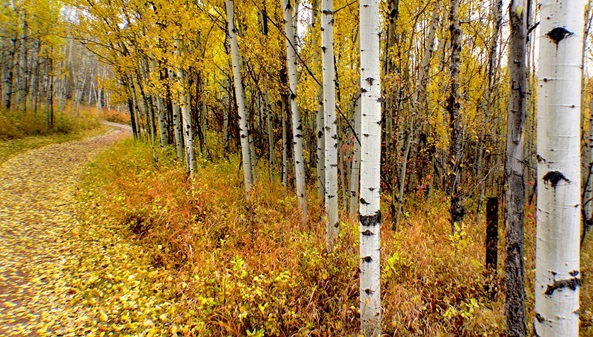.
To the Autumn Birches
The languid light of waning day
Glares undiffused by any cloud,
Still strong, defying its decay,
Then breaks on a dark colonnade—
Oak, ash, and beech—a somber crowd
Of mourners cloaked in winter’s shade.
But you—you stun the dozing gaze;
You stand apart and deign not weep,
Casting mourning’s grim gown away,
And dare to shine as shadows grow,
Awake when all around you sleep,
Illumined with a radiant glow
As though with your own inner light
Like columns in the Aegean sun,
Of stainless marble, gleaming white,
Crowned with cascading golden tresses,
Glittering as the breezes run,
And shake them loose with soft caresses.
But let none dare call you coquette
You shine because you know the morn
Past night that others see not yet.
Prophetess of the spring’s rebirth!
You show its light to those who mourn,
Brightening autumn with your mirth.
.
.
Adam Sedia (b. 1984) lives in his native Northwest Indiana and practices law as a civil and appellate litigator. He has published four books of poetry and his poems, essays, and fiction have appeared in various literary journals. He is also a composer, and his musical works may be heard on his YouTube channel.















Adam, this is a beautiful ode to the birch tree set in autumn splendor looking forward to spring. As a young boy living in the upper Midwest, I used to love going to the Black Hills and seeing them. This is an entrancing poem filled with alliteration and sensory detail.
Thank you! This was a “moment of inspiration” poem that struck me while driving through the woods not far from my home.
I was watching fred and the crew in chile and saw it’s time for today’s morning poem. Last night I felt bittersweet cause I was the “odd man out” and had no one to share that poem with but this one is so pretty I read it out loud. Mission success. Thanks boys!
Thank you! I love finding out that my work has given someone enjoyment.
Very beautiful work, Adam. When one sees the word Birches in the title, one always recalls Frost’s wonderful poem. But with this stanzaic and rhyme pattern, you have made the topic your own. Well done.
Thank you! Frost’s work looms large, I admit, but I wasn’t going to let that deter me from expressing inspiration I genuinely felt. I’m happy to see my own voice come through.
Incidentally, my favorite birch poem is Tolkien’s “Bagme Bloma,” written in the Gothic language.
A lovely poem on autumn birches, deftly handled with tercets. I think it is a good idea to divide the text into tercets throughout, even where there is enjambment from the closing line of one to the opening of the next. If the poet had avoided all line breaks, the poem would not be as attractive, and would have appeared bunched-up or congealed.
I bring this up because I think we who write formal poetry don’t often talk about the independent aesthetic value of divisions such as quatrains, couplets, tercets, and larger stanzaic ones. These divisions add a symmetry, an elegance, a formality, and even a kind of welcome severity to a poem, whereas their absence presents the reader with just a mass of words, especially if enjambment is employed.
Some poets refuse to enjamb from one division break to another, and I suppose that this is correct in larger stanzas or strophes. But enjambment between the smaller tercets or quatrains is perfectly natural, since it does not interfere with reading, and it presents a cool regularity on the printed page.
In Adam’s poem, the tercets are by themselves beautiful, as if they were copying the straight, clean lines of the birch trees they describe. And the line spaces make the linked central rhyme of each pair of tercets stand out all the more clearly.
Thank you for the compliments. And you raise an important point, which is ironically supported by the way “contemporary mainstream” poets handle their line-breaks. One thing that struck me about Billy Collins and others was how formal their poems look at first glance, with tercets or quatrains of even lines — until you actually read them. I think their style implicitly acknowledges the aesthetics of how a printed poem is supposed to look. The regular verses and stanzas imply musicality — regularity and repetition (as in the verses of a song).
In my own reading, I find I gravitate towards poems with shorter stanzas. They seem more inviting, at least when I want a quick read, without committing to sitting down and reading the poem like a story or novel.
A fabulous poem with play of language and form at many levels. Best is the springful light of the birches, making seasonal hope the prime and lasting emotion. But this proceeds from the languid, defiant sunset light, and overtops the darkness of other kinds of trees in authentic praise for the birches, not just description of them. The comparison with white columns in Aegean sun specifies their light as classic in its way. I especially like “glittering as the breezes run,” a genuine video of how birch leaves move. The subtle move to personify one prototypical birch tree as a woman of beauty and virtue gives the poem’s ending a clear and pure as well as mirthful feeling.
I second what Joseph Salemi says about the “welcome severity” and “cool regularity” of these tetrameter tercets. And his observation that the column of verse is practically a shape poem. The dark sections in white birch bark rarely circle the trunk, but larger ones do present differentiating marks in a pattern comparable to blank lines between regular stanzas in this beautiful work.
Thank you! I was driving home one afternoon from some completely mundane task and as I passed through a wooded area I saw this group of birches that completely stood out in the late afternoon light against the drab backdrop of the rest of the trees. I wanted to do that vision justice, and I’m happy to see my work resonate.
Your analogy between the printed lines and the patterns on the birches’ trunks is both apt and insightful. I confess it is not something I intended when I chose this form, but I readily endorse the analysis. Perhaps it was an act of the subconscious.
This is a truly beautiful word painting; your poem shines with even more brilliance than the photograph. “As though with your own inner light” really grabbed my attention, since I have so often marvelled at yellow-leaved trees that look like lit lamps, even on cloudy days, as if light was coming from the leaves.
I love this rhyme scheme, with the interlocking second lines of each tercet.
And you’ve gone further than description; you’ve personified the trees, and given them thoughts that with their brilliance they want to share with others, such as the “mourners cloaked in winter’s shade”.
If I may inject a note of dissent, I have sometimes found birches to be a pernicious weed tree. In Maine, when I was working for an old friend of mine, I cut down hundreds of them because there were just too damn many, to the detriment of other, more desirable species. In my own back yard, my neighbor’s river birch (Betula nigra) robbed me of precious light and incessantly rained dead twigs down on my patio. He finally had the damn thing cut down because it threatened to fall down on his house. Having said that, I would rather read a thousand of your poems than have a single birch tree planted in my neighborhood. Context is everything.
The birches that inspired this poem were growing in the wild. As beautiful as I considered them then, I would never plant them near my house. They are dirty trees. Although I do find birch beer one of their other redeeming qualities.
Thank you! Autumn is when the birches really pop out against the rest of the trees, and I wanted to capture that vision.
I love this poem, Adam! As a lover of summer I view autumn as the announcement of another long and weary winter. It marks the end of the baseball season, to boot! I find it almost impossible to appreciate the multicolored landscape of trees bearing dying foliage that some people drive hours to adore. I am more pleased with green. I mourn the lowering temperatures and shortening daylight hours. And the hovering thought of W I N T E R !
But your poem paints a new picture in my mind, a picture of majesty amid mourning, light defying darkness. I could highlight many lines, as others more apt than I have done, but the line that grabs me most is “Prophetess of the spring’s rebirth!” It mimics the telescopic nature of much biblical prophecy that makes the insufferable sufferable in view of the glory it precedes. And it makes me want to wander in search of the birch!
Thank you! It is wonderful to know that I could put a “new spin” on autumn for you. For me personally, Autumn – October specifically – is one of my favorite times of year. The temperatures really don’t start to fall until towards Halloween, and all the best flavors are in season: pumpkin, persimmon, sassafras, apple cider. And the trees burst with color – sort of a final party before winter sets in.